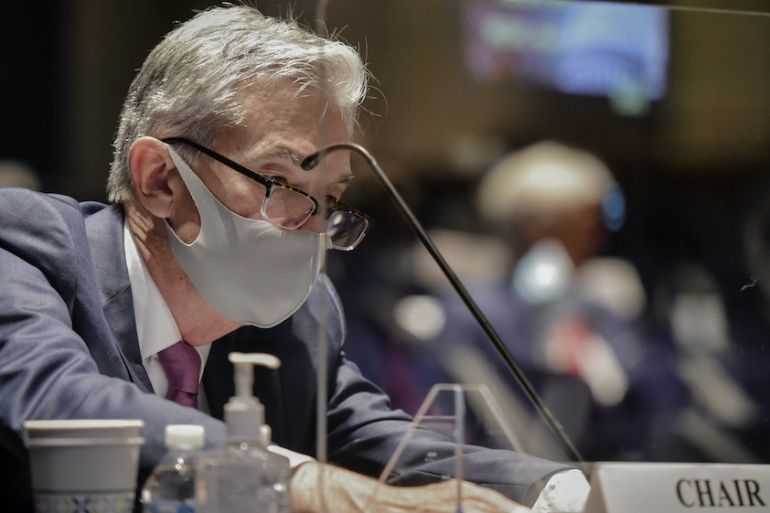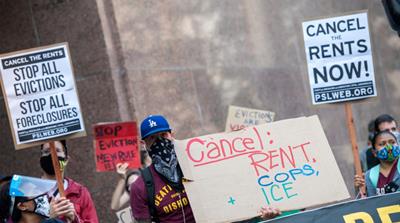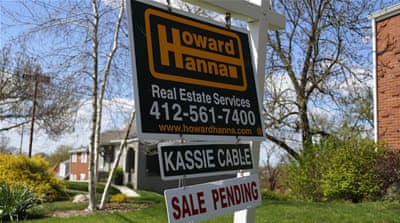Powell poised to deliver speech that has Fed watchers buzzing
Federal Reserve chief could signal a profound policy shift on inflation aimed at shoring up struggling US economy.

For decades, the United States Federal Reserve made clear its readiness to raise borrowing costs at the earliest signs of creeping inflation.
That was then. In a sign of how vastly the US economic landscape has changed, Fed Chairman Jerome Powell may be on the verge of sending a wholly different message this week: That the Fed plans to leave its key rate pinned near zero even after inflation has surpassed the central bank’s target level – at least for a while.
Keep reading
list of 4 itemsParallel economy: How Russia is defying the West’s boycott
US House approves aid package worth billions for Ukraine, Israel
Ecuador weighs security, international arbitration in latest referendum
Behind the Fed’s new thinking is an ailing economy in the grip of a viral pandemic and a stubbornly low inflation rate that has long defied the Fed’s efforts to raise it.
On Thursday, Powell will address the Fed’s annual gathering of global central bankers, normally held in picturesque Jackson Hole, Wyoming, amid the towering Grand Teton mountain range but this time being conducted virtually. The conference is occurring just as the Fed is nearing the end of a comprehensive review of its monetary policy. While its conclusions may not be announced until the Fed holds its next meeting in September, Powell will likely preview its message in his speech Thursday.
The widespread expectation is that the Fed is poised to adopt a more flexible policy that would allow inflation to overshoot its 2 percent annual target for some period to compensate for the many years in which inflation has run below 2 percent.

It is called “average inflation targeting”. The goal would be to drive home to borrowers and investors that the Fed’s benchmark rate – which influences many consumer and business loans – will stay ultra-low for likely years to come.
What is new is the message that the Fed is prepared to accept a level of inflation that in the past it would not have tolerated while keeping rates near record lows.
The Fed chairman is speaking at a perilous time. Unemployment is still in double digits, and roughly one million people are applying for jobless aid each week even as the amount of aid they receive has shrunk. Consumer confidence has tumbled. Though the stock market and home sales are surging, the economy is struggling to grow, and millions face potential evictions from their homes.
Against that backdrop, Powell may also discuss other options that the Fed and Congress could pursue. As he has before, the chairman could press Congress to resolve its political impasse and expand upon the $3 trillion in aid it has provided to cushion the damage the pandemic has inflicted on households, school districts, small businesses and local and state governments.
“The Fed is in a position where they see the recovery is losing momentum at a time when the economy is in a deep hole, and that is worrisome,” said Diane Swonk, chief economist at auditing firm Grant Thornton, who, like many analysts, says she worries about a possible double-dip recession.
The chairman’s speech to an annual gathering of central bank officials is normally a hot ticket in the economic world, with coveted invitations going to a select few. This year, the event is being livestreamed to all on the YouTube site of the Federal Reserve Bank of Kansas City, which sponsors it.
Previous Fed chairs, notably Alan Greenspan and Ben Bernanke, sometimes used the Jackson Hole conference to announce major policy initiatives during turbulent economic times, which is one reason why expectations are high that Powell could do the same. The title of his speech, Monetary Policy Framework Review, refers to the 18-month study the Fed undertook beginning in 2019, which included town-hall sessions with ordinary Americans, to assess its interest rate policies and communications strategies and decide on any changes.

The minutes of its most recent policy meeting in late July indicated that an announcement was expected soon. That has prompted speculation that Powell will discuss the changes on Thursday, with a formal adoption of the proposals when the Fed next meets in mid-September.
The most consequential change would be for the Fed to replace the 2 percent annual inflation target it adopted in 2012 – and has never managed to reach consistently – with some form of average inflation targeting. It would mean that the Fed could raise rates more slowly in coming years even if inflation starts to rise. Right now, the Fed’s preferred inflation gauge is hovering at a sub-1 percent annual rate, well below the 2 percent target.
Among other ideas, Fed officials have also discussed the possibility of adopting what is called yield control. This would entail setting a target yield for, say, the 10-year Treasury and then tailoring the Fed’s purchases of Treasuries to keep the yield at that level. But this proposal appears to have fallen out of favour because of objections that it would require the Fed to exert too much control over long-term rates.
Another possibility is that the Fed will expand its “forward guidance” – the wording in its policy statements that is intended to signal when it will likely adjust its benchmark rate.
The policymakers have also discussed a form of guidance it has used in the past: It could signal that it is unlikely to raise rates until a certain period had passed or a certain goal had been achieved, perhaps a reduction in unemployment to a specific rate.
There is also the possibility that Powell could announce an expansion in the eligibility for some of the emergency lending programmes it established after the pandemic hit or perhaps an increase in the amount of Treasuries it is buying each month to keep long-term rates low.
Yet with borrowing rates already ultra-low, many analysts wonder whether any of these proposals would go very far to invigorate the economy.
“The Fed has already said it will keep rates low for the foreseeable future, and no one expects any rate hikes before the end of 2021,” said Sung Won Sohn, economics and business professor at Loyola Marymount University in Los Angeles.
Many economists say the biggest economic benefit would come from a new emergency aid programme from Congress. Lawmakers left town without extending some critical support programmes, including a now-expired $600-a-week federal top-up to state unemployment benefits.
“I hope he uses this speech to urge lawmakers to act,” said Mark Zandi, chief economist at Moody’s Analytics. “I hope he says that we are a long way from normal, and for us to get back to normal Congress needs to step up and provide more support.”
Zandi and other analysts have warned that without more government support, the country could easily suffer a double-dip recession.
“This economy is still struggling with a double-digit unemployment rate, and the risks are very high that if we don’t do more, we could go back into a recession,” he said.